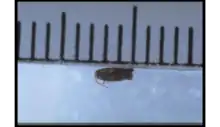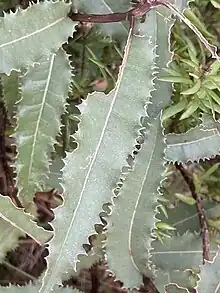Stigmella erysibodea
Stigmella erysibodea is a species of moth of the family Nepticulidae.[2] It is endemic to New Zealand and has been observed in both the North and South Islands. The larvae of this species are leaf miners and feed on the leaves of Olearia ilicifolia and Olearia albida. Adults have been observed on the wing in November and February.
| Stigmella erysibodea | |
|---|---|
 | |
| Male holotype | |
| Scientific classification | |
| Domain: | Eukaryota |
| Kingdom: | Animalia |
| Phylum: | Arthropoda |
| Class: | Insecta |
| Order: | Lepidoptera |
| Family: | Nepticulidae |
| Genus: | Stigmella |
| Species: | S. erysibodea |
| Binomial name | |
| Stigmella erysibodea Donner & Wilkinson, 1989[1] | |
Taxonomy
This species was first described in 1989 by Hans Donner and Christopher Wilkinson from specimens collected in the Taupō, Taranaki and Fiordland regions.[3] The male holotype specimen, collected at Lyttle's Flat, Hollyford Valley on the 3 February 1976 "on Olearia ilicifolia" by J. S. Dugdaleis, is held at the New Zealand Arthropod Collection.[3]
Description
Donner and Wilkinson described the adult male of this species as follows:
Head. Frontal tuft white; scape brown; collar brown-grey; antenna brown, comprising 42 segments. Thorax brown-grey. Forewing 3-4 mm long, slender, with fore and hind margins more or less parallel; browngrey with irregularly scattered paler spots, lustrous, reflecting smooth silvery grey that seems to cover wing with a thin, transparent layer; fringe brown, short, thickly set. Hindwing and fringe grey. Abdomen brown-grey.[3]
Donner and Wilkinson also described the female of the species as follows:
As for male, but with about 30 antennal segments, and wing fringe longer.[3]
S. erysibodea is similar in appearance to S. atrata, however it is smaller in size.[3]
Distribution
S. erysibodea is endemic to New Zealand.[4][5] It has been observed in both the North and South Islands.[6][3]
Behaviour
The larvae mine the leaves of their host plants.[7] Adults have been observed on the wing in November and February.[3]
Host

The larvae have been shown to feed on Olearia ilicifolia, a species that is endemic to New Zealand, and also Olearia albida, a south-eastern Australian species cultivated in New Zealand, as the moth has been successfully reared from both these plants.[7]
References
- "Stigmella erysibodea Donner & Wilkinson, 1989". biotanz.landcareresearch.co.nz. Retrieved 2023-10-05.
- Erik J van Nieukerken; Camiel Doorenweerd; Robert J B Hoare; Donald R Davis (31 October 2016). "Revised classification and catalogue of global Nepticulidae and Opostegidae (Lepidoptera, Nepticuloidea)". ZooKeys. 628 (628): 65–246. doi:10.3897/ZOOKEYS.628.9799. ISSN 1313-2989. PMC 5126388. PMID 27917038. Wikidata Q28109648.
- Hans Donner; Christopher Wilkinson (28 April 1989). "Nepticulidae (Insecta: Lepidoptera)" (PDF). Fauna of New Zealand. Department of Scientific and Industrial Research. 16: 21. doi:10.7931/J2/FNZ.16. ISSN 0111-5383. OCLC 924829916. Wikidata Q45079930. Archived from the original (PDF) on 26 July 2021.
- Gordon, Dennis P., ed. (2010). New Zealand inventory of biodiversity: Kingdom animalia : chaetognatha, ecdysozoa, ichnofossils. Vol. 2. p. 461. ISBN 978-1-877257-93-3. OCLC 973607714. OL 25288394M. Wikidata Q45922947.
- "Stigmella erysibodea Donner & Wilkinson, 1989". biotanz.landcareresearch.co.nz. 7 October 2014. Retrieved 2023-10-05.
- "Stigmella erysibodea Donner & Wilkinson, 1989". www.nzor.org.nz. Landcare Research New Zealand Ltd. Retrieved 2018-07-12.
- "Stigmella erysibodea Donner & Wilkinson, 1989". plant-synz.landcareresearch.co.nz. 2011. Retrieved 2018-07-12.